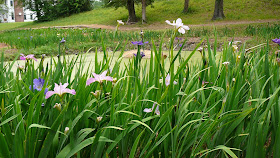Louisiana irises are the official "wildflower" of the state of Louisiana. The official flower of the state of Louisiana is the magnolia, which is also the state flower of several of the southern states.
Louisiana irises, or LA (for short) irises, are beardless irises of the species Iris.Hexagonae. They are commonly referred to as Louisiana irises although they are grown throughout the world and across the United States. They are native flowers originally found in the bayous and marshes of South Louisiana, along the Mississippi River, and across most of the southern states.
 |
| 'Cotton Plantation' by Mary Dunn (1994) |
Louisiana irises are water loving irises and are heavy feeders. If they are not watered enough in the long dry summers, they will simply go dormant and wait for the fall rains. Although they really like water, they can be grown with other plants. I grow them with many different plants and in many different ways. I find they grow well in pots, in raised beds, in dug beds, in the edge of ponds or streams, and just about any other way of growing plants. Much emphasis is put on their desire for water; however, they will grow fine without being soaked in water. They do like to have almost full sun. I suggest you try to shield them from the very hot afternoon sun if you live in a very hot-summers type of climate.
I have heard "They are hard to grow!" This is a statement I heard from gardeners even in the state of Louisiana. This is simply not true. I even went to Fort Worth, TX to give a talk to a group of iris lovers on growing Louisiana irises and was told they could not grow them in the Fort Worth area. I found that interesting because the Dallas iris group has many members growing Louisiana irises and had hosted the Society for Louisiana Irises convention in past years and will again host the convention in 2013.
This picture (click on it for a larger view) was taken in my front yard area a while back. I had dug up all the Louisiana irises in the raised bed at the top of the picture and just thrown them down on the ground by the edge of the bed. I amended the soil in the bed and then replanted the irises. I obviously missed some of them because a few months later I took this picture of the "missed" irises growing right where I had thrown them. I believe that you can throw a Louisiana iris on the ground, sort of push it down in the dirt with your foot, and it will grow!
This picture was taken in an area we call the "deer meadow" and shows Louisiana irises growing with poppies and many other "wildflowers".
This picture shows Louisiana irises growing in the edge of a small pond (called a "tank" in Texas) we call "rock pond" because it has a large limestone rock in the middle of the pond.
So, in summary, Louisiana irises are easy to grow. They do like a lot of water. Do not plant them in your cacti bed but you can certainly grow them with many other plants. They like to be fed at least twice a year and we feed them in the fall and about a month before they bloom in the spring. They like sunlight and if they do not get enough direct sunlight, they will produce nice foliage but will probably not bloom for you. They are grown from Maine to Florida, from Florida to California, from California to Washington, and in most states in between. They are grown in New Zealand, Australia, South America, England, parts of Canada, Russia and many other nations of the world.
Here are some interesting commercial web sites that will give you more information on growing Louisiana (LA) irises:
Aitken's Salmon Creek Gardens
Bois d'Arc Gardens
Iris City Gardens
Louisiana Iris Farms
Louisiana Iris Gardens
Seabrook Nursery and Gardens
Zydeco Louisiana Iris Gardens
Bois d'Arc Gardens
Iris City Gardens
Louisiana Iris Farms
Louisiana Iris Gardens
Seabrook Nursery and Gardens
Zydeco Louisiana Iris Gardens
Next time we will go into more detail about how to plant those Louisiana irises. So, look at some of these sights and start picking out the ones you want to grow!



I like your surname, but isn't it long enough already without the "s"?. I have found one of the Louisiana species growing wild along the Wabash River in central Indiana (Zone 5) so they can be plenty hardy. Many (but not all) grow well here in Michigan. The yellow Koorawatha gave us a great show last year. Since the city planners of Chicago are designing their infrastructure for a climate similar to Baton Rouge by the end of this century we soon should soon be able to grow them all like you.
ReplyDeleteIt is Killingworth in England, there is actually a "Killingworth" town in England. That's where my ancestors came from but when they got to the USofA, someone stuck a "s" in the name. There is a huge garden of LA irises in Rochester, NY, in the Friendship Garden. They stay under snow most of the winter.
ReplyDelete